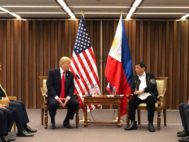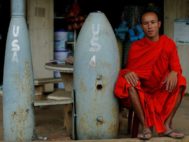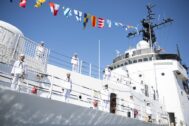Authors
Sheldon Simon

Sheldon W. Simon is professor in the School of Politics and Global Studies at Arizona State University and a faculty associate of ASU’s Center for Asian Research. He is a senior adviser to The National Bureau of Asian Research and has been a consultant to the Departments of State and Defense. Currently, he is also an academic associate of The National Intelligence Council. Simon is the author or editor of ten books and 200 scholarly articles and book chapters dealing with Asian security in such journals as Asian Survey, Pacific Affairs, Asian Security, Asian Forum, Pacific Affairs, NBR Analysis, and The Pacific Review. He has held a number of visiting professorships in the United States and Canada, most recently in 2010 at the U.S. Naval War College.
Articles by Sheldon Simon

US - Southeast Asia
September — December 2017Abandoning Leadership
Concerned about what Southeast Asian leaders see as US neo-isolationism under President Donald Trump, the heads of government from Vietnam, Malaysia, Thailand, and Singapore all visited Washington in the last four months of 2017. Trump’s trip to Asia in November led to additional talks with Vietnam’s leaders and Philippine President Rodrigo Duterte. These activities could be termed “shopping diplomacy” in that each leader has sought to curry favor with the United States and all announced plans to purchase more US goods and invest in US companies to help Washington reduce its balance of payments deficit. They also emphasized that their economic infusions in the US would generate thousands of new US jobs. Politically, their combined message was that the US should not leave Southeast Asia to China’s tender mercies but that Washington should remain a major actor in the region’s security, economic activities, and political organizations.

US - Southeast Asia
May — August 2017Regional Skepticism
Unlike its predecessor, the Trump administration has not devoted much attention to Southeast Asia; there is no clear policy toward the region. Instead, two areas have been emphasized: an increase in the number of Navy ship-days in the South China Sea and regular economic pressure on Southeast Asian states based on the president’s “America First” principle. Insofar as there is a security policy, it has been to gain support for Washington’s efforts to isolate North Korea. US relations with the Philippines have improved because there have been limited complaints about President Duterte’s war on drugs and increased support for the Philippine Armed Forces’ counterterrorism actions in Mindanao. Vietnam Prime Minister Nguyen Xuan Phuc’s trip to Washington focused on reducing Hanoi’s trade surplus, and, in August, Secretary of Defense Mattis promised a visit by a US aircraft carrier to Vietnam, the first since the end of the Vietnam War. Washington applauded the ASEAN-China agreement on a framework for a code of conduct for the South China Sea, urging that the actual code be legally binding, a stipulation opposed by China.

US - Southeast Asia
January — April 2017Mixed Messages
In its early months, the Trump administration has devoted little attention to Southeast Asia and US relations with the region have generally followed a trajectory set by the Obama administration. The US continued naval operations in the South China Sea and joint exercises with most ASEAN states with US air and naval forces rotating through bases in northern Australia and the Philippines and deploying from Singapore. There have been mixed signals between Manila and Washington. With the ASEAN states and China moving toward completion of a Code of Conduct (COC) on rules of engagement in the South China Sea, it is hoped that the new document would be “legally binding,” but little specific about its provisions has been published. Following Washington’s abrogation of the Trans-Pacific Partnership (TPP), Hanoi has sought to alleviate its disappointment, saying that it understands the US need to create more jobs and that it will try to accommodate Washington in future trade negotiations.
During the Obama administration’s two terms (2009-2016), the president’s “rebalance” to Asia featured Southeast Asia as its centerpiece. President Obama made 11 separate trips to the Asia-Pacific, visiting a total of 14 countries, nine of which were members of ASEAN. His secretaries of state and defense also made multiple journeys to the region. Among many successes during these years were US accession to ASEAN’s Treaty of Amity and Cooperation, participation in the East Asia Summit for the first time in 2011, the establishment of the first diplomatic mission to ASEAN, and realization of the historic transition to democracy in Myanmar. The United States also increased the deployment of ships and aircraft to the region, particularly in Singapore, the Philippines, and Australia. In Obama’s final year, the US began distributing resources under the Maritime Security Initiative to assist Southeast Asian countries with their maritime domain awareness by transferring patrol vessels and surveillance aircraft as well as creating a system whereby these countries could share information on the region’s maritime security picture.
While it’s still early for the Trump administration, there have been virtually no policy statements dealing with Southeast Asia, nor at this time (April) has the State Department chosen a deputy secretary – the number two position – or a permanent assistant secretary for East Asian and Pacific affairs. Direction from Washington for a region that was so important during the preceding eight years seems to be absent.

US - Southeast Asia
September — December 2016Philippine Follies
The rather bizarre behavior of Philippine President Rodrigo Duterte dominated the news in late 2016. The former Davao mayor displayed his well-known anti-US feelings while aggressively pursuing his allegedly extrajudicial campaign against Philippine drug trafficking. Duterte’s invective ran the gamut from accusations that the US still treated the Philippines as a colony to a vulgar epithet directed at President Obama. There were also threats to end all bilateral military exercises and to terminate bilateral defense agreements. Philippine officials tried to soften Duterte’s remarks and US officials offered reassurances that the US would remain a reliable defense partner and planned to continue providing military assistance. Elsewhere, the US continued to focus attention on maritime security while avoiding direct involvement in the emerging controversy over treatment of the Muslim population in Rakine State, Myanmar.
US - Southeast Asia
May — August 2016Augmented Presence
The Obama administration has achieved only a portion of its Asian rebalance strategy in Southeast Asia. Washington is repositioning elements of the US Navy to the Pacific, engaging in “freedom of navigation patrols,” and providing assistance to Vietnam and the Philippines to monitor and defend their maritime territories. US leaders are regularly attending ASEAN-based meetings to demonstrate US commitment to Asia. President Obama regularly promotes the Tran-Pacific Partnership (TPP). Despite these advances, US presidential electoral politics are presenting new obstacles. Meanwhile, the US has urged caution with respect to the UNCLOS Arbitral Tribunal’s decision on the South China Sea. Human rights concerns continue to trouble US relations with Hanoi as well as Bangkok, Nay Pyi Taw, Vientiane, and Phnom Penh.
US - Southeast Asia
January — April 2016ASEAN Centrality?
The mid-February ASEAN-US Summit was the Obama administration’s effort to show ASEAN’s central role in the US rebalance to Asia. It was only partially successful. Several new business initiatives were inaugurated to link US and ASEAN entrepreneurs. However, security cooperation hardly advanced. While maritime security was included in the joint declaration, there was no mention of US freedom of navigation (FON) patrols or the South China Sea disputes. In January, the Philippine Supreme Court cleared the way for the Philippine-US Enhanced Defense Cooperation Agreement, allowing US forces rotational access to several Philippine military bases and enhancing interoperability. Washington plans to increase the frequency and “complexity” of FON patrols near the artificial islands built by China, and the US has begun joint patrols with Philippine ships. Washington also announced a Southeast Asian Maritime Security Initiative that includes a $425 million multi-year appropriation for regional capacity to improve maritime domain awareness and patrols.
US - Southeast Asia
September — December 2015Commitment Concerns
US relations with Southeast Asia encompassed all three pillars of its rebalance to Asia: military presence, multilateral diplomacy, and economic engagement. Militarily, the freedom of navigation voyage of the USS Lassen past China’s artificial islands occurred while the Department of Defense announced a $425 million five-year military aid program for Southeast Asian states and the White House committed an additional $259 million in military support for Indonesia, Malaysia, and the Philippines. Diplomatic engagements included visits to the region by the president, the secretaries of state and defense, and a number of senior aides to attend multilateral meetings. Commitment to the economic pillar led to the conclusion of negotiations for the Trans-Pacific Partnership (TPP) trade agreement. If ratified by the signatories, the TPP would be the most comprehensive trade and investment arrangement in the world, though a number of obstacles in many of the countries do not portend a quick or easy confirmation.
US - Southeast Asia
May — August 2015Courting Partners
Senior State and Defense Department officials made several visits to Southeast Asia over the summer months, assuring their hosts that the US remained committed to a robust air and naval presence in the region, and assisting the littoral countries of the South China Sea in developing maritime security capacity. Washington is particularly focused on providing a rotational military force presence in Southeast Asia. On the South China Sea territorial disputes, US officials emphasized the need for peaceful approaches to conflict settlement among the claimants, pointing to arbitration and negotiation based on the 1982 UN Convention on the Law of the Sea. Washington has also accentuated the importance of security partners for burden-sharing, noting the potential for an enhanced role for Japan’s Maritime Self-Defense Force in South China Sea patrols. Efforts to involve Southeast Asian states in negotiating the Trans-Pacific Partnership (TPP) have elicited candidates from only four of the 10 ASEAN states – Malaysia, Vietnam, Singapore, and Brunei. Others have problems meeting several requirements associated with the partnership.
US - Southeast Asia
January — April 2015South China Sea Wariness
In the first four months of 2015, senior State and Defense Department officials as well as flag-rank military officers visited Southeast Asia, all emphasizing ASEAN’s importance for the Obama administration’s rebalance policy. The US is building a rotational force deployment capacity in the region along with military assistance to allies and partners, especially for increasing their maritime security capabilities. Washington and Manila await a Supreme Court decision regarding the constitutionality of the April 2014 Enhanced Defense Cooperation Agreement (EDCA), which will permit better access for US forces. Washington has also emphasized Vietnam’s importance to the rebalance, currently concentrating on improving coast guard relations. However, the US was dismayed that Hanoi permitted Russian tanker aircraft to fly out of Cam Ranh Bay to refuel bombers that flew near US bases in Guam. The Indonesian Navy has shown interest in more naval exercises with the US around the Natuna Islands. Problems persist in US-Thai relations as the military consolidates its rule. Although the annual Cobra Gold exercise took place in February, Washington scaled back US participation and significantly reduced the kinetic component. Planning for next year’s exercise is in limbo. Finally, Japan and India have shown support for maritime security buildups and an enhanced naval presence in the South China Sea.
US - Southeast Asia
September — December 2014Diplomatic Gambits
Senior US officials at ASEAN-based meetings touted the Association’s centrality for the Obama administration’s rebalance to Asia. Nevertheless, a US proposal at the East Asia Summit (EAS) in November that all South China Sea claimants “freeze” efforts to alter the status quo on the islets they control was not endorsed. In the Philippines, there was some progress on implementing the Enhanced Defense Cooperation Agreement, though opponents have challenged its constitutionality. The US partially lifted its arms embargo with Vietnam, agreed to resume Cobra Gold in Thailand in 2015, and expressed approval of Indonesia’s ambitious maritime development program. Human rights concerns were noted by US officials in response to ongoing ethnic tensions in Burma and the Najib government’s decision to repeal the 1948 Sedition Act in Malaysia.